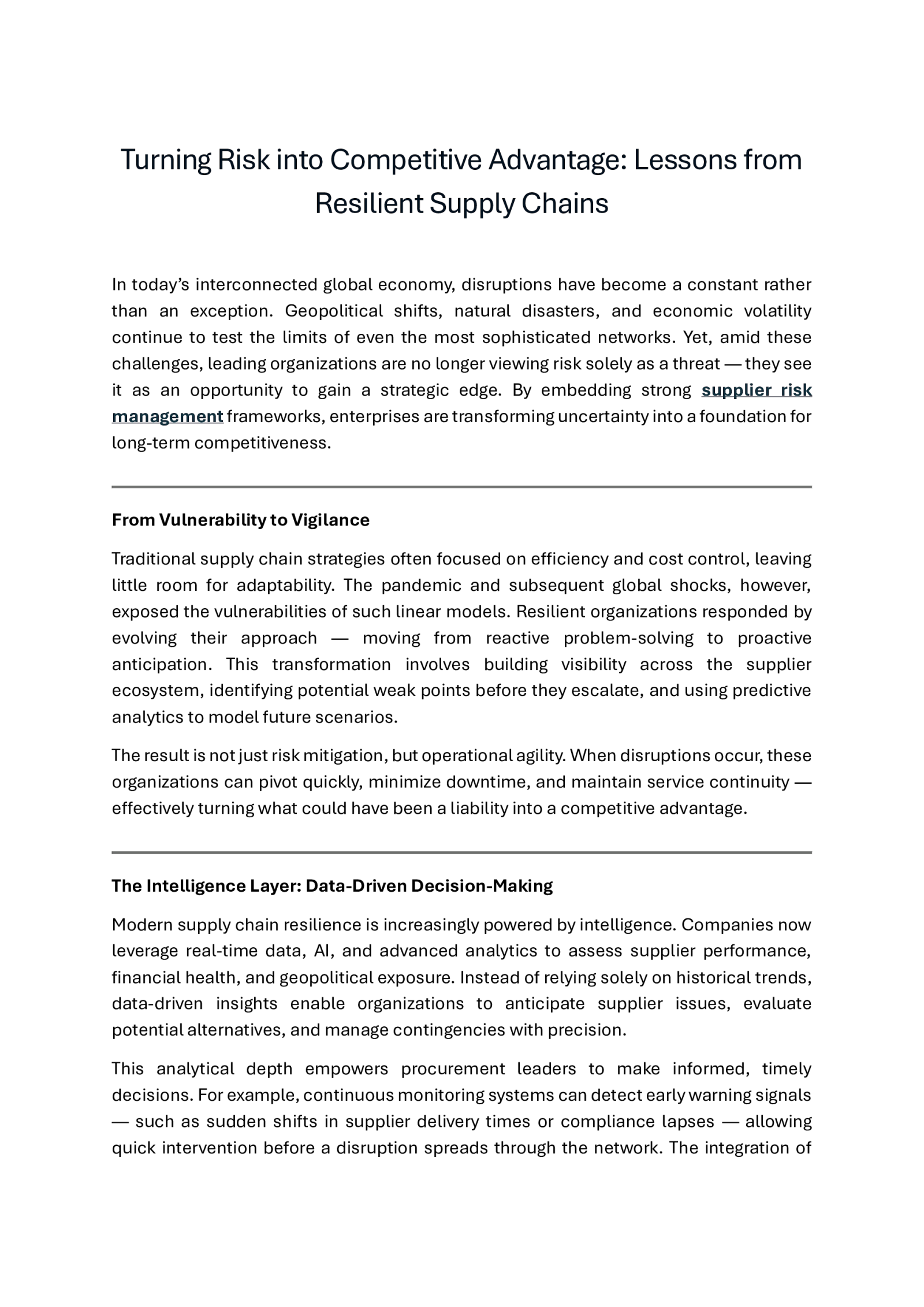A presentation at Supplier Risk Management Framework for Strategic Stability in in New York, NY, USA by Linda Farrar

Turning Risk into Competitive Advantage: Lessons from Resilient Supply Chains In today’s interconnected global economy, disruptions have become a constant rather than an exception. Geopolitical shifts, natural disasters, and economic volatility continue to test the limits of even the most sophisticated networks. Yet, amid these challenges, leading organizations are no longer viewing risk solely as a threat — they see it as an opportunity to gain a strategic edge. By embedding strong supplier risk management frameworks, enterprises are transforming uncertainty into a foundation for long-term competitiveness. From Vulnerability to Vigilance Traditional supply chain strategies often focused on efficiency and cost control, leaving little room for adaptability. The pandemic and subsequent global shocks, however, exposed the vulnerabilities of such linear models. Resilient organizations responded by evolving their approach — moving from reactive problem-solving to proactive anticipation. This transformation involves building visibility across the supplier ecosystem, identifying potential weak points before they escalate, and using predictive analytics to model future scenarios. The result is not just risk mitigation, but operational agility. When disruptions occur, these organizations can pivot quickly, minimize downtime, and maintain service continuity — effectively turning what could have been a liability into a competitive advantage. The Intelligence Layer: Data-Driven Decision-Making Modern supply chain resilience is increasingly powered by intelligence. Companies now leverage real-time data, AI, and advanced analytics to assess supplier performance, financial health, and geopolitical exposure. Instead of relying solely on historical trends, data-driven insights enable organizations to anticipate supplier issues, evaluate potential alternatives, and manage contingencies with precision. This analytical depth empowers procurement leaders to make informed, timely decisions. For example, continuous monitoring systems can detect early warning signals — such as sudden shifts in supplier delivery times or compliance lapses — allowing quick intervention before a disruption spreads through the network. The integration of
such digital intelligence has become the hallmark of a forward-looking, risk-resilient supply chain. Collaboration as a Strategic Shield Resilience does not emerge from technology alone; it is equally rooted in collaboration. Building stronger partnerships with suppliers fosters transparency, shared accountability, and mutual trust. Open communication ensures that both parties can align on goals, sustainability priorities, and crisis response mechanisms. Forward-thinking organizations also recognize that resilience extends beyond tier-one suppliers. Understanding and engaging with sub-tier networks helps create a multilayered defense, reducing dependency on single sources. This holistic approach strengthens the supply chain fabric, making it less susceptible to cascading failures during disruptions. Embedding Sustainability and Ethics into Risk Strategy The definition of risk in supply chains has expanded to include environmental, social, and governance (ESG) factors. Ethical sourcing, carbon footprint reduction, and regulatory compliance are now integral to long-term resilience. By embedding sustainability into risk frameworks, organizations not only mitigate potential reputational and operational threats but also align themselves with evolving stakeholder expectations. This shift reflects a deeper understanding that responsible operations and competitive advantage are no longer mutually exclusive — they are intrinsically connected. Sustainable resilience is now a marker of credibility, trust, and future-readiness in the global marketplace. The Future: From Resilience to Reinvention The next frontier in supply chain management lies in adaptive ecosystems — networks capable of self-assessing, learning, and evolving in real time. As technology and collaboration deepen, the ability to sense, respond, and recover will define success. Resilience, therefore, is no longer just about withstanding disruptions; it’s about emerging stronger and smarter after them. Organizations that master this balance — combining intelligence, agility, and ethical foresight — will lead the way in transforming risk into a strategic differentiator. In a world of constant change, resilience is not just a shield against uncertainty; it is the blueprint for sustainable growth.
Learn how to mitigate supplier risks with a strategic framework for procurement resilience compliance and long term operational stability.